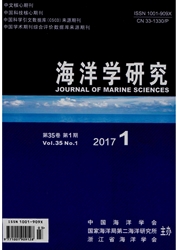

 中文摘要:
中文摘要:
利用卫星遥感资料反演出的海洋大气参数,应用目前世界较为先进的通量算法(CORAER3.0),计算了西太平洋区域海-气热通量(感热通量和潜热通量)。首先分析了海-气热通量的多年平均场和气候场变化的基本特征,以及年际和年代际变化特征;进而对其与南海夏季风爆发之间的关系进行了初步探讨。结果表明,西太平洋海-气热通量具有明显的时空分布特征,感热通量的最大值出现在黑潮区域,潜热通量的最大值出现在北赤道流区和黑潮区域。在气候平均场中,黑潮区域的感热通量和潜热通量最大值均出现在冬季,最小值出现在夏季;暖池区域感热通量除了春季较小外,冬、夏和秋季基本相同,而潜热通量最大值出现在秋、冬季,最小值出现在春、夏季。另外,海-气热通量还具有显著的年际变化和年代际变化,感热通量和潜热通量均存在16a周期,与南海夏季风爆发存在相同的周期。由相关分析可知,4月份暖池区域的海-气热通量与滞后3a的南海夏季风爆发之间存在密切相关关系,这种时滞相关性,可以用于进行南海夏季风爆发的预测,为我国汛期降水预报提供科学依据。基于以上结论,建立多元回归方程对2012年的南海夏季风爆发进行了预测,预测2012年南海夏季风爆发将偏晚1-2候左右。
 英文摘要:
英文摘要:
Based on the oceanic and atmospheric parameters retrieved from the satellite remote-sensing data with the neural network method, the air-sea heat fluxes over the western Pacific warm pool area were calculated with the advanced method of CORARE 3.0 bulk algorithm. The variation of multiyear averaged field and climate field as well as the interannual and interdecadal variation of the air-sea heat fluxes were analyzed first, and their relations with the onset of the SCS summer monsoon were discussed primarily. The results indicate that the air-sea heat fluxes have obvious characteristics of temporal and spatial distribution. The maximum sensible heat flux occurs in the Kuroshio area, while that of the latent heat flux in the North Equator Current and the Kuroshio areas. And the distribution of the averaged annual air-sea heat fluxes shows that both the sensible heat flux and latent heat flux in Kuroshio area have maximum value in winter and minimum value in summer, while the latent heat flux in western Pacific warm pool area has maximum value in autumn and winter, minimum value in spring and summer, and the sensible heat flux has the minimum in spring and basically the same values in other seasons. Furthermore, the air-sea heat fluxes have obvious interannual and interdecadal variations. Both the sensible heat flux and latent heat flux have 16 a period, which is the same as the SCS summer monsoon onset. The correlation analysis shows that there is a close correlation between the air-sea heat fluxes in April in the warm pool area and the onset of SCS summer monsoon three years later. And the lag-correlation could be used to predict the onset of SCS summer monsoon and provide scientific basis for the estimation of precipitation in the flood season. Based on these results, a multivariate regression equation was established to predict the onset of the SCS summer monsoon in 2012, which shows that it will be 1-2 pentads later than the normal year.
 同期刊论文项目
同期刊论文项目
 同项目期刊论文
同项目期刊论文
 期刊信息
期刊信息
